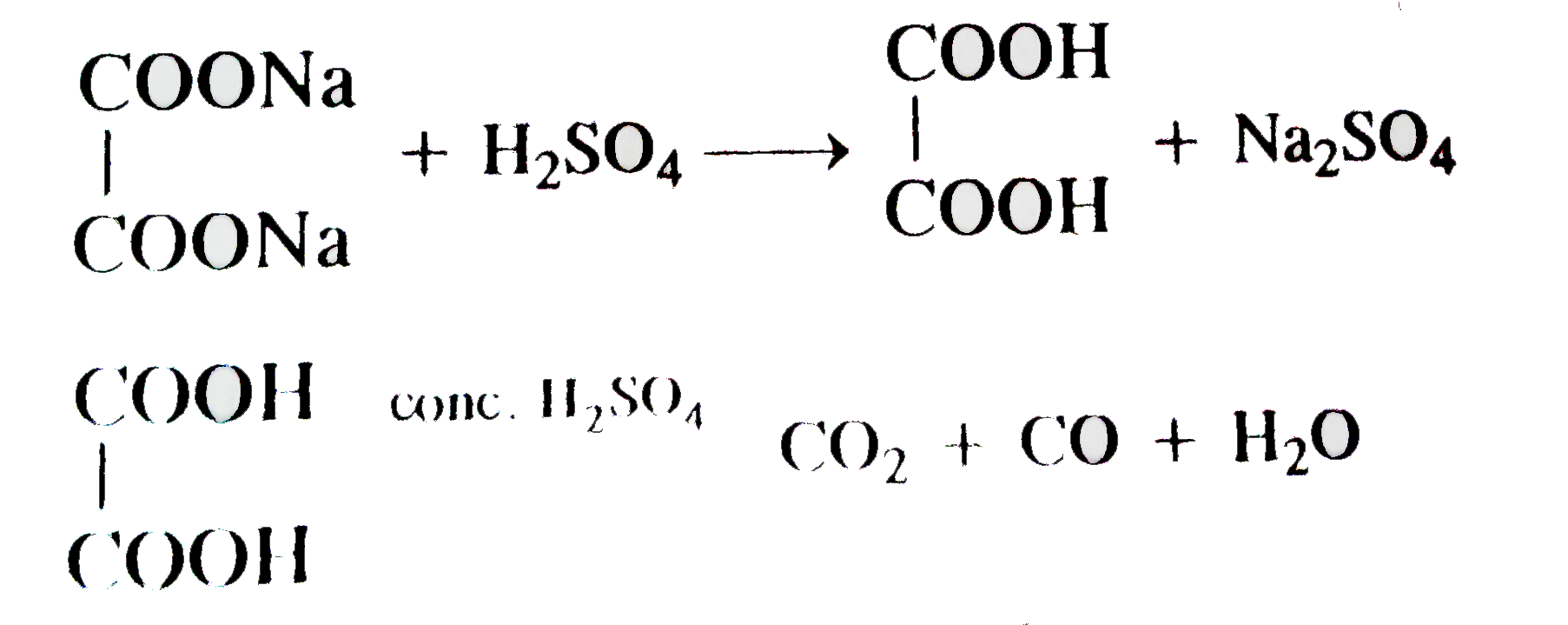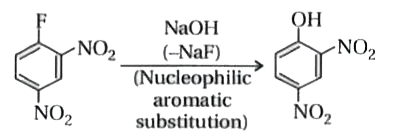InterviewSolution
This section includes InterviewSolutions, each offering curated multiple-choice questions to sharpen your knowledge and support exam preparation. Choose a topic below to get started.
| 351. |
Whichof the followingis morebasic amine ? |
|
Answer» `(CH_(3))_(2)NH` |
|
| 352. |
Which electrolyte is used in Dennis method for the prepartion of fluorine ? |
|
Answer» `KHF_2` in ANHYDROUS HF |
|
| 353. |
Which of the following polymers can have strog intermolecular forces. |
|
Answer» NYLON |
|
| 354. |
The standard reduction potential for Zn^(2+)//Zn, Ni^(2+)//Ni and Fe^(2+)//Fe are -0.76,-0.23 and -0.44" V " respectively. The reaction X+Y^(2+) to X^(2)+Y will have more negative DeltaG value when X and Y are |
|
Answer» X=Ni, Y=Fe `DELTAG=-nFE_(cell)`. Greater the value of `E_(cell)`.more will be the value of `DeltaG`. For this, the difference between `E^(@)` values of `X^(2+)` and `Y^(2+)` must be maximum. This MEANS that X=Zn and Y=Ni. |
|
| 355. |
The standard reduction potential for Zn^(2+)//Zn, Ni^(2+)//Ni and Fe^(2+)//Fe are -0.76,-0.23 and -0.44" V " respectively. The reaction X+Y^(2+) to X^(2)+Y will be spontaneous when : |
|
Answer» X=NI, Y=Fe For REACTION to be spontaneous,`E^(@)` must be positive `E_(Zn^(2+)//Zn)^(@)+E_(Ni^(2+)//Ni)^(@)=0.76+(-0.23)=0.53` (positive). |
|
| 356. |
The structure of neopentane is : |
|
Answer» `CH_(3)CH_(2)CH_(2)CH_(2)CH_(3)` |
|
| 357. |
whathappenwhen : (a)Dry sodium propionate is heatedwithsodaaline ? ( b)Electroysis of anaqueoussolutionof potassiumacetateis done? ( C)Ethyl iodineis treatedwithphosphousand hydrogeniodine? ( d)Electrolysis of anaqueoussolutionofpotassiumacetaneis done ?,(e)Ethyl iodinedissolvedindry etheris treatedwithsodiummetal ? (f) Methaneis treatedwithiodinein presenceof anoxidisingagent ? (g)n- Hexaneis treatedwihCr_(2)O_(3)supportedoveraluminaat 873 K? (h) Ethaneis treated withconc , nitricacid at 723 K? (i) Lithiumdimethyl cuprateis treatedwith ethylbromide? |
|
Answer» Solution :`C_(2)H_(5)COONa+NaOHoverset(CaO)to C_(2)H_(6)+Na_(2)CO_(3)` `(B) Al_(4)C_(3)+12H_(2)Oto 3CH_(4)+4Al(OH)_(3)` `( C) (i) 3C_(3)H_(5)I+3HIoverset(423K)to 3C_(2)H_(6)+3I_(2)` `(ii) 2P+3l_(2)to 2Pl_(3)` `(d) 2CH_(3)COOK+2H_(2)O to C_(2)H_(6)+2CO_(2)+2KOH+H_(2)` `( E) 2C_(2)H_(5)I+2Nato C_(4)H_(10)+2Nal` `(f ) (i) CH_(4)+I_(2)hArrCH_(3)I+HI` `(ii) 2HI+Oto H_(2)O+I_(2)` (G)`C_(6) H_(14)underset(873K)overset(Cr_(2)O_(3)//Al_(2)O_(3))to C_(6)H_(6)+4H_(2)` `(H) C_(2)H_(6)+HNO_(3)overset(723K)to C_(2)H_(5)NO_(2)+CH_(3)NO_(2)` (i)` Li (CH_(3))_(2)CuH_(5)Brto C_(3)H_(8)+C_(3)H_(8)+CH_(3)CU+Li Br` |
|
| 358. |
Vapour pressure of chloroform (CHCl_(3)) and dichloromeane (CH_(2)Cl_(2)) at 298 K are 200 mm Hg and 415 mm Hg respectively.(i) Calculate the vapour pressure of the solution prepared by mixing 25.5 g of CHCl_(3) and 40 g of CH_(2)Cl_(2) at 298 K and,(ii) Mole fractions of each component in vapour phase. |
|
Answer» Solution :(i) Molar mass of `CH_(2)Cl_(2)` `=12xx1+1xx2+35.5xx2` `= 85 G mol^(-1)` (ii) Molar mass of `CHCl_(3)` `=12xx1+1xx1+35.5xx3` `=119.5 g mol^(-1)` Moles of `CH_(2)Cl_(2) = (40G)/(85g mol^(-1))=0.47` mol Moles of `CHCl_(3)=(25.5g)/(119.5 g mol^(-1))=0.213`mol Total number of moles `= 0.47+0.213` = 0.683 mol `chi_(CH_(2)Cl_(2))=(0.47 mol)/(0.683 mol)=0.688` `chi_(CHCl_(3))=1.00-0.688 = 0.312` Using equation (2.16) `p_("total")=p_(1)^(0)+(p_(2)^(0)-p_(1)^(0))chi_(2)` `= 200+(415-200)xx0.688` `=200+147.9=347.9` mm HG (ii) Using the relation `p_(i)=y_(1)//p_("total")` we can calculate the MOLE : `p_(CH_(2)Cl_(2)=0.688xx415` mm Hg = 285.5 mm Hg `p_(CHCl_(3))=0.312xx200` mm Hg = 62.4 mm Hg `y_(CH_(2)Cl_(2))=285.5` mm Hg/347.9 mm Hg = 0.82 `y_(CH_(2)Cl_(3)=62.4` mm Hg/347.9 mm Hg = 0.18 Note:since, `CH_(2)Cl_(2)`is a more volatile component than `CHCl_(3)`. `[p_(CH_(2)Cl_(2))^(0)=415 " mm Hg and " p_(CHCl_(3))^(0)=200 " mm Hg"]` andthe vapour phase is also richer in `CH_(2)Cl_(2)`. `[y_(CH_(2)Cl_(2))=0.82 " and " y_(CHCl_(3))=0.18]` It may thus be concluded that at equilibrium,vapour phase will be always rich in the component which is more volatile. |
|
| 359. |
Write the formula of the noble gas species whicg is isostructural with IBr_(2)^(-). |
| Answer» SOLUTION :`IBr_(2)^(-)` is isostructural with `XeF_(2)`. | |
| 360. |
Which of the following species is diamagnetic? |
|
Answer» `Ti^(2+)(Z=22)` |
|
| 361. |
Theory of ionization was given by |
|
Answer» Rutherford |
|
| 362. |
What happens when metyl isocyanide reacts with the following reagents? (i) Mineral acid (ii) Na+C_(2)H_(5)OH |
|
Answer» Solution :(i) `underset("Methyl isocyanide")(CH_(3)-NC+2H_(2)O) underset("ACID")(to)underset("Methyl amine" (1^(@)))(CH_(3)NH_(2))+underset("Formic acid")(HCOOH)` (ii) `underset("Methyl isocyanide")(CH_(3)-NC)+4[H] overset(Na//C_(2)H_(5)OH)(to) CH_(3)-underset("DIMETHYL amine"(2^(@)))underset(H)underset(|)(N)-CH_(3)` |
|
| 363. |
Whichof the followingis responsiblefor herditycharacter ? |
| Answer» ANSWER :A | |
| 364. |
What are emulsions ? What are their different types ? Give example of each type. |
|
Answer» SOLUTION :COLLOIDAL dispersion of one liquid into other IMMISCIBLE liquid. In other words, both dispersed phase and the dispersion MEDIUM are immiscible liquids is known as emulsion. Classification of emulsion. : (i)OIL-in-water, water acts as dispersion medium. For example : Milk, vanishing cream.(ii) Water-in-oil, oil acts as dispersion medium. For example : Butter, cold cream. |
|
| 365. |
The reducing agent used in wolf-kishner reduction is ................ |
| Answer» SOLUTION :`NH_2 - NH_2 + C_2H_5ONa` | |
| 366. |
Which product is formed , when acetonitrile is hydrolysed partially with dil . HCl ? |
|
Answer» Acetic acid |
|
| 367. |
Which of the following produces a mixture of CO and CO_2 by reaction with H_2SO_4 ? |
|
Answer» SODIUM acetate 
|
|
| 368. |
Which is the strongest base among the following? |
| Answer» Answer :a | |
| 369. |
Which plot is the adsorptoion isobar for chemisorption where m (at constant pressure ) at temperatureT ? |
|
Answer» ` (##DPB_PHY_CHM_IX_C13_E01_018_O01.png" width="30%">. |
|
| 370. |
Which of the following polymer can be formed by using the following monomer unit? |
| Answer» Answer :D | |
| 371. |
Write the names and structures of the monomers of the following polymers: (i) Buna-S (ii) Buna-N (iii) Dacron (iv) Neoprene. |
|
Answer» Solution :(i) Buna - N : `CH_(2) = underset("1,3 -Butadiene")(CH) = CH_(2) = CH_(2) and C_(6)H_(5) - underset("Styrene")(CH) =CH_(2)` (ii) Buna` - N : CH_(2) = underset("1,3- Butadiene")(CH) - CH = CH_(2) and CH_(2) = underset("Acrylonitrile")(CH) - CN` DACRON: `HO - underset("Ethylene glycol")(CH_(2)-CH_(2)) - OH ` and  (iv)Neoperene : `underset("CHLOROPRENE or 2 - chloro - 1,3-butadiene")(CH_(2) = overset(Cl) overset(|)(C) - CH = CH_(2))` |
|
| 372. |
Which of the following is the uppermost rexampleion of the atmosphere ? |
|
Answer» Stratosphere |
|
| 373. |
The temperature , at which the vapour pressure of a liquid becomes equal to the atmospheric pressure is known as |
|
Answer» Freezing POINT |
|
| 374. |
Which of the following reaction can be used to define the heat of formation of CO_(2)(g) |
|
Answer» `C("graphite")+O_(2)(G)=CO_(2)(g)` |
|
| 375. |
Which does not form amalgam |
|
Answer» Fe |
|
| 376. |
Which of the following is correct order for basic nature? |
|
Answer» `CH_(3)FgtCH_(3)OHgtCH_(3)NH_(2)` |
|
| 377. |
What is the major product obtained by mono-chlorination of 2-methylbutane |
| Answer» SOLUTION :2-methylbutane give form mono chlorination PRODUCTS. Among the form 2-chloro 3-methyl is the MAJOR product following the REACTIVITY, SELECTIVITY | |
| 378. |
What is ''semi permeable membrane''? |
| Answer» Solution :A semipermeable membrane is a continuous SHEET or film of suitable material (natural or synthetic) which has PORES such that solvent MOLECULES can PASS through but big molecules of the solute cannot. | |
| 379. |
Which ofthe followingsubstitutedbenzene derivativeswould furnish three isomer when onemore substituent is introduced ? |
|
Answer»
|
|
| 380. |
triangleS is postive for the change: |
| Answer» Answer :D | |
| 381. |
Which metals play an important role in the development of human civilization? |
| Answer» Solution :Fe and Cu | |
| 382. |
When electricity is passed through aqueous solution of aluminium chloride. 13.5 g of Al are deposited. The number of Faradays of electricity passed must be |
|
Answer» 2 |
|
| 383. |
What is the influence of added non-volatile solute on the boiling point of solvent ? |
| Answer» Solution : The vapour pressure of solvent in a solution is less. Therefore temperature must be RAISED to make the vapour pressure of the solution equal to the ATMOSPHERIC pressure. Hence, BOILING point of solution will be greater than that of the solvent. | |
| 384. |
The sodium chloride is used in the manufacture of - |
| Answer» Answer :D | |
| 385. |
The strongest oxidant |
|
Answer» `F_(2)` |
|
| 386. |
What is the product formed in the following reaction C_(6)H_(5)OH+C Cl_(4)underset((2)" "H^(+))overset((1)" "NaOH)to |
|
Answer» p-hydroxybenzoic acid |
|
| 387. |
Ylide is the reagent used in |
|
Answer» Reformatsky REACTION |
|
| 388. |
Which of the following sets contain only additionhomopolymers ? |
|
Answer» Polythene , NATURAL rubber , CELLULOSE |
|
| 389. |
What type of substances would make better permanent magnets, ferromagnetic or ferrimagnetic ? Justify your answer. |
| Answer» Solution :FERROMAGNETIC SUBSTANCES MAKE better permanent magnets. Metal ions in ferromagnetic substance are grouped into small regions called domains. Each domain acts as a tiny magnet. These domains are oriented in a random manner. When placed in a magnetic field, these domains or tiny magnets get oriented in the direction of the magnetic field and a strong magnetic effect is produced. The effect persists even after removal of magnetic field. This BEHAVIOUR is not EXPECTED from ferrimagnetic substances. | |
| 390. |
Which of the following hydroxide has more covalent character ? |
| Answer» Answer :C | |
| 391. |
Which of the following will have highest pH value in water solution ? |
| Answer» Answer :B | |
| 392. |
There are three isomeric compounds P,Q,R with molecular formula C_(4)H_(6)O_(3).Compound P is a saturated hydroxy carboxylic acid.Compound Q is a symmetrical anhydride while R is an aldehydic ester. Which of the following is P? |
|
Answer»
|
|
| 393. |
The transition elements are more metallic then p - block elements because they have |
|
Answer» ELECTRON PAIRS in d- orbitals |
|
| 394. |
Volume of a mixture of 6.02xx10^(23) oxygen atoms and 3.01xx10^(23) hydrogen molecules at NTP is: |
|
Answer» 28.0litre |
|
| 395. |
Two radio isotopes A and B of atomic mass X and Y are mixed in equal amount by mass. After 20 days , their mass ratio is found to be 1:4. Isotope A has a half-life of 1 day. The half-life of isotope B is : |
| Answer» Answer :D | |
| 396. |
Which represents nucleophilic aromatic substitution reaction ? |
|
Answer» Reasction of BENZENE with `Cl_(2)` in sunlight 
|
|
| 397. |
Which of the following has lowest first ionisation enthalpy? |
|
Answer» 1. Mg |
|
| 398. |
Which of the following statement are true regarding the log K vs 1//T. Plot shown in the given diagram? |
|
Answer» <P>Plot P shows that the energy of ACTIVATION is independent of temperature |
|
| 399. |
Write the reactions of the final alkylation product of aniline with excess of methyl iodide in presece of sodium carbonate solution. |
|
Answer» SOLUTION :`C_6 H_5+CH_3 I to[C_6 H_5overset(+ )(NH_2) CH_3 ]I^(-)` ` 2[C_6 H_5overset(+ )NH_2CH_3 ]I^(-) +Na_2 CO_3to 2C_6NHCH_3CH_3 +2NAL +CO_2+H_2 O` `C_6H_5 NHCH_3underset( Na_2 CO_3) OVERSET(CH_3 I)to C_6 H_5N (CH_3)_2` ` C_6 H_5 N (CH_3)_2 +CH_3 I to underset("N,N,N-Trimethylaniliniumiodide")([C_6 H_5 overset(+)N (CH_3)_3 ]I^(-) underset(Na_2CO_3) overset(-2Nal)to+ underset("N.N.N-Trimethylanilinium carbonate ")( [C_6 H_5overset(+) N (CH_3)_3 ]_2CO_(3)^(2-))` |
|
| 400. |
What are the hydrolysis products of . (i)sucrose and (ii) lactose ? |
Answer» SOLUTION :Sucrose on hydrolysis gives one molecule each of glucose and fructose while LACTOSE on hydrolysis gives one molecule each of glucose and galactose, as SHOWN by the following reactions : 
|
|